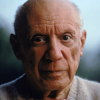Pablo Picasso

Pablo Picasso
Pablo Ruiz y Picasso, also known as Pablo Picasso, was a Spanish painter, sculptor, printmaker, ceramicist, stage designer, poet and playwright who spent most of his adult life in France. Regarded as one of the greatest and most influential artists of the 20th century, he is known for co-founding the Cubist movement, the invention of constructed sculpture, the co-invention of collage, and for the wide variety of styles that he helped develop and explore. Among his most famous works are...
NationalitySpanish
ProfessionPainter
Date of Birth25 October 1881
CityMalaga, Spain
CountrySpain
Variation does not mean evolution. If an artist varies his mode of expression this only means that he has changed his manner of thinking, and in changing, it might be for the better or it might be for the worse.
I have never had time for the idea of searching. Whenever I wanted to express something, I did so without thinking of the past or the future.
If I paint a hammer and sickle people may think it is a representation of Communism, but for me it is only a hammer and sickle. I just want to reproduce the objects for what they are, not for what they mean.
Neither is there figurative and non-figurative art. All things appear to us in the shape of forms. Even in metaphysics ideas are expressed by forms. Well then, think how absurd it would be to think of painting without the imagery of forms. A figure, an object, a circle, are forms; they affect us more or less intensely.
Do you think it interests me that this painting represents two figures? These two figures existed, they exist no more. The sight of them gave me an initial emotion, little by little their real presence grew indistinct. They became a fiction for me, then they disappeared, or rather, were turned into problems of all kinds. For me they are no longer two figures but shapes and colours. Don't misunderstand me: shapes and colours, though, that sum up the idea of the two figures and preserve the vibration of their existence.
He was an Afghan Hound name Kabul. Since him I have had other Afghan Hounds.... Perhaps I am looking for his ghost. He is the only one that I sometimes think about. Often, if he comes in to my mind when I am working, it alters what I do. The nose on the face I am drawing gets longer and sharper. The hair of the woman I am sketching gets longer and fluffy, resting against her cheeks like his ears rested against his head.
I've reached the moment where the movement of my thought interests me more than the thought itself.
I paint what I think, not what I see.
We might adapt for the artist the joke about there being nothing more dangerous than instruments of war in the hands of generals. In the same way, there is nothing more dangerous than justice in the hands of judges, and a paint brush in the hands of a painter! Just think of the danger to society! But today we haven't the heart to expel the painters and poets because we no longer admit to ourselves that there is any danger in keeping them in our midst.
One does a whole painting for one peach and people think just the opposite - that particular peach is but a detail.
What do you think an artist is An imbecile who has only his eyes if he is a painter, or his ears if he is a musician, or a lyre at every level of his heart if he is a poet, or, if he is merely a boxer, only his muscle On the contrary, he is at the same time a political being, constantly alert to the heartrending, burning, or happy events in the world, molding himself in their likeness.
I paint objects as I think them, not as I see them.
He can who thinks he can, and he can't who thinks he can't. This is an inexorable, indisputable law.
I should like to live like a poor man, with a great deal of money